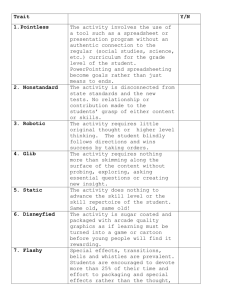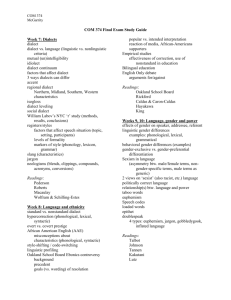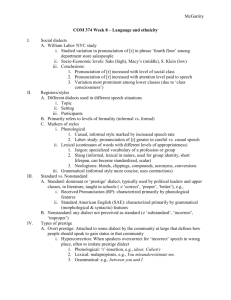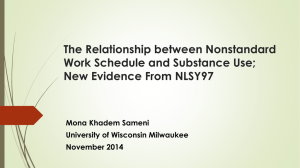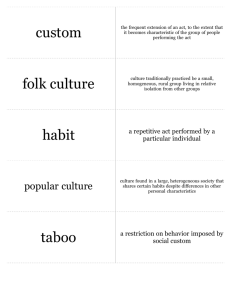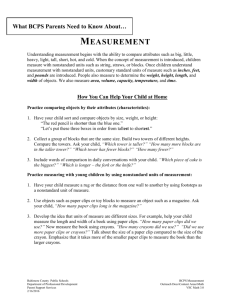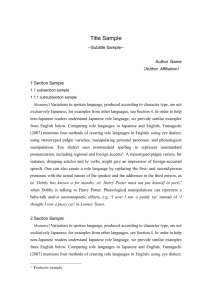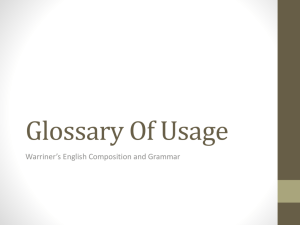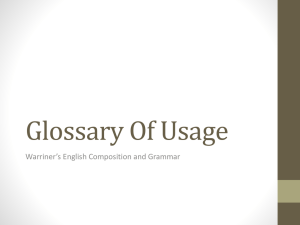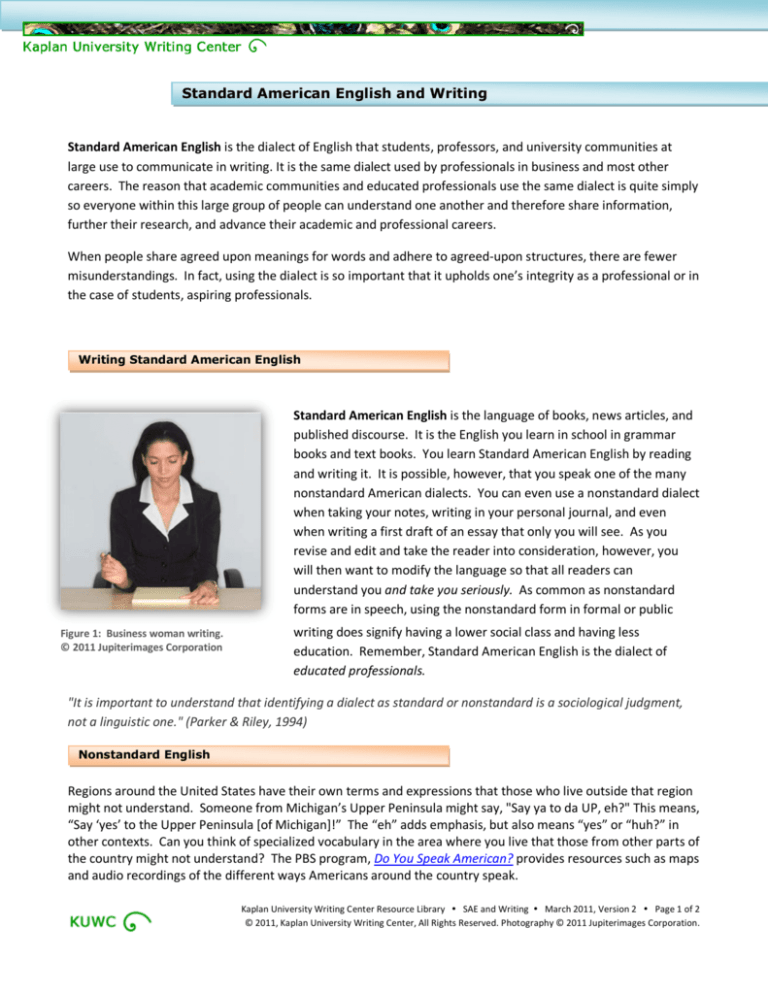
Standard American English and Writing
Standard American English is the dialect of English that students, professors, and university communities at
large use to communicate in writing. It is the same dialect used by professionals in business and most other
careers. The reason that academic communities and educated professionals use the same dialect is quite simply
so everyone within this large group of people can understand one another and therefore share information,
further their research, and advance their academic and professional careers.
When people share agreed upon meanings for words and adhere to agreed-upon structures, there are fewer
misunderstandings. In fact, using the dialect is so important that it upholds one’s integrity as a professional or in
the case of students, aspiring professionals.
Writing Standard American English
Standard American English is the language of books, news articles, and
published discourse. It is the English you learn in school in grammar
books and text books. You learn Standard American English by reading
and writing it. It is possible, however, that you speak one of the many
nonstandard American dialects. You can even use a nonstandard dialect
when taking your notes, writing in your personal journal, and even
when writing a first draft of an essay that only you will see. As you
revise and edit and take the reader into consideration, however, you
will then want to modify the language so that all readers can
understand you and take you seriously. As common as nonstandard
forms are in speech, using the nonstandard form in formal or public
Figure 1: Business woman writing.
© 2011 Jupiterimages Corporation
writing does signify having a lower social class and having less
education. Remember, Standard American English is the dialect of
educated professionals.
"It is important to understand that identifying a dialect as standard or nonstandard is a sociological judgment,
not a linguistic one." (Parker & Riley, 1994)
Nonstandard English
Regions around the United States have their own terms and expressions that those who live outside that region
might not understand. Someone from Michigan’s Upper Peninsula might say, "Say ya to da UP, eh?" This means,
“Say ‘yes’ to the Upper Peninsula [of Michigan]!” The “eh” adds emphasis, but also means “yes” or “huh?” in
other contexts. Can you think of specialized vocabulary in the area where you live that those from other parts of
the country might not understand? The PBS program, Do You Speak American? provides resources such as maps
and audio recordings of the different ways Americans around the country speak.
Kaplan University Writing Center Resource Library SAE and Writing March 2011, Version 2 Page 1 of 2
© 2011, Kaplan University Writing Center, All Rights Reserved. Photography © 2011 Jupiterimages Corporation.
One of the most common nonstandard dialects is Southern English, known for its inclusion of double modals: “I
might could go” and the use of don’t and won’t or weren’t instead of “doesn’t” and “wasn’t”: “He don’t want to
go”; “I weren’t looking for it.” African American English also includes distinct, nonstandard patterns such as
double negatives: “I didn’t go nowhere” as well as absent auxiliary verbs: “he comin” instead of “he is coming.”
Notice, too, the dropped “g” from “coming” and “working.”
“Standard American English is the common language of educated professionals and is understood by people
across different geographical regions, educational backgrounds, and ethnic and racial associations.” (KU
General Education Literacy Rubric)
Another common example of nonstandard, colloquial English that
many students might need to edit in their final drafts is the use of a
singular verb with a plural subject: “They was important” or a singular
subject with a plural verb: “she write poetry.” Standard American
English is also known as Edited English since the writing process does
allow for the use of nonstandard forms in the early stages of the
process. Remember, however, that writing meant to be read by others
should conform to the clear and concise style and complete sentence
structures of Standard American English.
Figure 2: Student typing on laptop.
© 2011 Jupiterimages Corporation
If you are writing fiction, however, and want to use dialogue to capture
a character’s personality or social or regional associations, then using a
nonstandard form would be effective. And whenever quoting
someone, you will want to use their words exactly, so if the speaker
used a nonstandard form, then that is the way you must quote it. Just
remember the quotation marks and the citation!
"Standard American English usage is linguistic good manners, sensitively and accurately matched to context--to
listeners or readers, to situation, and to purpose. But because our language is constantly changing, mastering its
appropriate usage is not a one-time task like learning the multiplication tables. Instead, we are constantly
obliged to adjust, adapt, and revise what we have learned." (Wilson, 1993)
Using Standard American English grants you an enormous vocabulary as well as an extensive variety of stylistic
choices regarding your degree of formality, so you can develop your own personal style. Using Standard
American English therefore indicates you are one of the group—an educated professional—and an individual. It
allows you to express your unique, individual voice.
References
Parker, F. & Riley, K. (1994). Linguistics for Non-Linguists. Allyn and Bacon.
Wilson, K. G. (1993). The Columbia Guide to Standard American English. New York: Columbia Univ. Press.
Kaplan University Writing Center Resource Library SAE and Writing March 2011, Version 2 Page 2 of 2
© 2011, Kaplan University Writing Center, All Rights Reserved. Photography © 2011 Jupiterimages Corporation.

